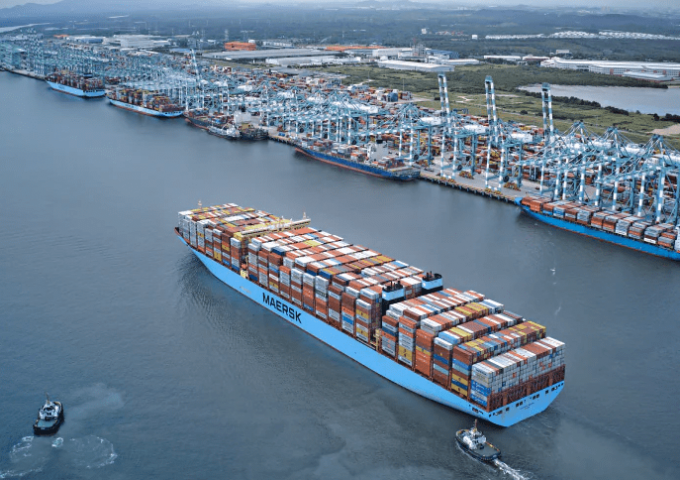Emirates airline and Iceland join Move to -15C Coalition
Emirates and UK supermarket Iceland have become the latest members of the Move to -15C ...
UPS: MULTI-MILLION PENALTY FOR UNFAIR EARNINGS DISCLOSUREWTC: PUNISHEDVW: UNDER PRESSUREKNIN: APAC LEADERSHIP WATCHZIM: TAKING PROFITPEP: MINOR HOLDINGS CONSOLIDATIONDHL: GREEN DEALBA: WIND OF CHANGEMAERSK: BULLISH CALLXPO: HEDGE FUNDS ENGINEF: CHOPPING BOARDWTC: NEW RECORDZIM: BALANCE SHEET IN CHECKZIM: SURGING
UPS: MULTI-MILLION PENALTY FOR UNFAIR EARNINGS DISCLOSUREWTC: PUNISHEDVW: UNDER PRESSUREKNIN: APAC LEADERSHIP WATCHZIM: TAKING PROFITPEP: MINOR HOLDINGS CONSOLIDATIONDHL: GREEN DEALBA: WIND OF CHANGEMAERSK: BULLISH CALLXPO: HEDGE FUNDS ENGINEF: CHOPPING BOARDWTC: NEW RECORDZIM: BALANCE SHEET IN CHECKZIM: SURGING

After a “better-than-expected” first quarter, as it rounded out the half-year, Maersk today claimed it had maintained strong momentum, boasting volume growth and improved financials.
However, improved or not, against 2023, its H1 financials looked weak, with group revenue down 7% year on year, from $27.2bn to $25.1bn, and the Ebitda fall was even sharper, down 47.7%, to $3.7bn, as Ebit collapsed, down 71%, to $1.1bn.
But, with Maersk having warned that 2024 could be a year of mounting losses, one analyst told The Loadstar that, while they were “barely acceptable”, it had reason to be pleased with the results – a stance CEO Vincent Clerc was more than happy to take up.
He said: “Our results confirm performance in all our businesses is trending in the right direction. Market demand has been strong and the situation in the Red Sea remains entrenched.
“This leads to continued pressure on global supply chains. These conditions are now expected to continue for the remainder of the year.”
And, with the unexpected positivity that followed its first-quarter earnings announcement, APMM Group confirmed an upward-revision of its full-year Ebitda and Ebit guidance: from $7bn to 9bn to $9bn-11bn; and $1-3bn to $3-5bn, respectively.
Mr Clerc told investors: “Market demand has so far been very strong, leading to an increase in our expectation.
“And we have terminals which continue to be strong. The segment [APMT] demonstrated excellent performance, leading to one of the highest levels ever. These developments…led us to raise our guidance for 2024.”
As for quarterly performance, the revenue drop was more muted, down just 1.5%, to $12.7bn, while Ebitda dropped 27.5%, to $2.1bn, and Ebit dipped 40%, to $963m.
Broken down divisionally, Ocean’s H1 revenue was down 12%, to $16.3bn, as both Ebitda and Ebit hurtled south, down 59% to $2.3bn and 90% to $309m, respectively, but Mr Clerc said the impact of Red Sea-induced higher rates would likely materialise in Q3.
For Q2, Ocean looked in a little better shape, with revenue down just 4%, to $8.3bn, Ebitda down 37%, to $1.4bn, with Ebit having fallen 61%, to $470m.
“We’re entering the ninth month of continued threats and attacks on vessels passing through the Red Sea and the situation on the ground is not good, it is entrenched, and we expect it to stay until the end of 2024,” said Mr Clerc.
“Market demand has so far been very strong, leading to an increase in our expectation, but we are uncertain to the extent of this in Q4.”
Logistics & Services division H1 revenue rose 4.4%, to $7.1bn, although this was not enough to offset a decline of 2% ino Ebitda and a 28% drop in Ebit, to $614m and $180m, respectively.
However, Q2 revenue (at $3.6bn), Ebitda ($348m), and Ebit ($126m) all climbed, up 7.3%, 9.6% and 3.5%, respectively.
Maersk attributed the quarter’s successes to “increased volumes across all product families, more than offsetting continued low rates”, as well as the “positive impact” coming out of an initiative to address challenges in North America ground freight.
However, as Mr Clerc had intimated, its best performing sector was its smallest: Terminals. For the six-month period, revenue grew a little under 6%, to $2.08bn, with Ebitda up 21.5%, to $756m, and Ebit rising 37%, to $653m. In Q2, revenue was $1.1bn, Ebitda $408m and Ebit $353m, up 14.6%, 23% and 31%, respectively.
Listen to this clip from the recent episode of The Loadstar Podcast to hear director of the Global Shippers Forum, James Hookham, discuss what shippers want from the Gemini Cooperation Maersk/Hapag-Lloyd alliance starting in 2025:
Comment on this article